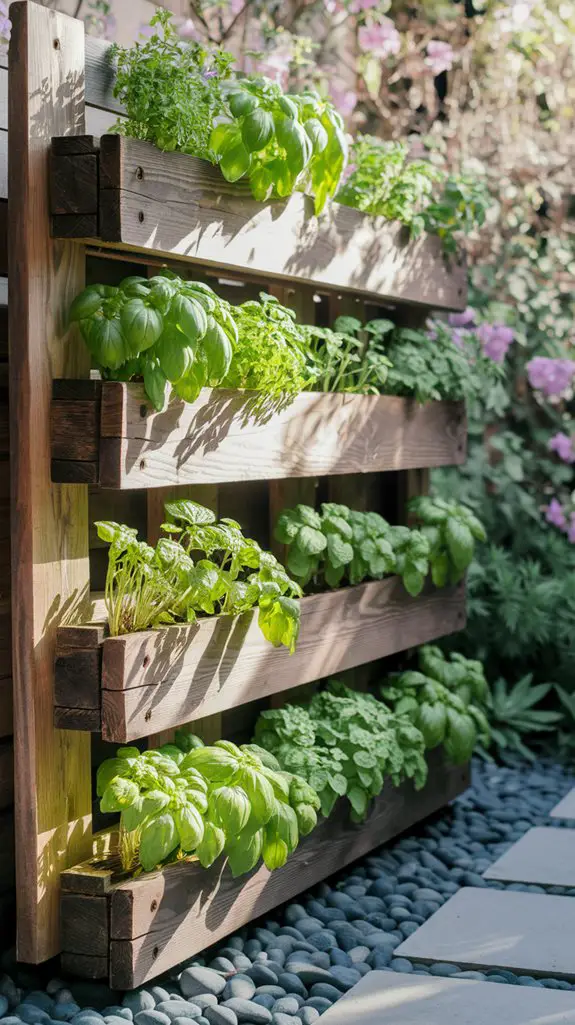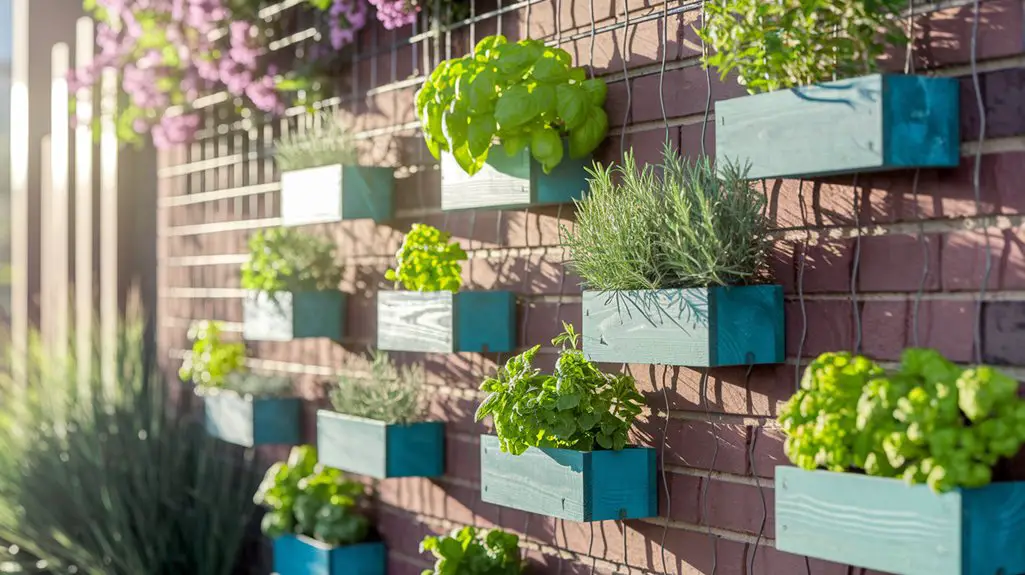Contrary to popular belief, you don't need sprawling garden beds to cultivate a diverse herb collection. With vertical gardening techniques, even the most spatial-constrained environments can support thriving Lamiaceae, Apiaceae, and other culinary herb families. Strategic vertical placement maximizes photosynthetic efficiency while minimizing footprint requirements. By implementing specialized container systems with proper drainage substrates, you'll transform underutilized spaces into productive microclimates. The following five structures offer practical solutions for your compact cultivation needs.
Wall-Mounted Herb Gardens Using Recycled Materials
While repurposing household items offers economic benefits, it also provides essential microhabitats for your culinary herbs. Retrofitted wooden pallets create perfect vertical growing spaces when lined with landscaping fabric to retain substrate while facilitating proper drainage. Position these structures against south-facing walls to maximize photosynthetic activity for Mediterranean species like Rosmarinus officinalis and Thymus vulgaris. For hydrophilic herbs requiring consistent moisture retention, repurposed plastic bottles function as self-contained propagation vessels. Simply excise the upper third, invert it to create a reservoir system, and incorporate capillary wicking material. This maintains ideal rhizosphere humidity for Mentha species and Coriandrum sativum. When utilizing metal containers, apply food-safe sealant to prevent mineral leaching that could alter soil pH and compromise root development. These systems require minimal spatial footprint while maximizing cultivation potential. Additionally, these budget-friendly solutions can significantly enhance your urban gardening experience.
Vertical Hanging Planter Systems for Indoor Herbs

Because most culinary herbs require minimum photosynthetically active radiation (PAR) of 30-50 μmol/m²/s, strategic positioning of suspended cultivation systems becomes essential for indoor applications. You'll find macramé hangers and tiered pendants particularly effective for maximizing vertical space while ensuring adequate light distribution for your aromatic specimens. Additionally, incorporating raised bed herb gardens can further enhance your indoor gardening experience by providing a structured environment for growth.
| System Type | Light Penetration | Suitable Herbs |
|---|---|---|
| Macramé Tiers | Moderate | Basil, Thyme |
| Window Chains | Excellent | Rosemary, Sage |
| Pulley Systems | Adjustable | Mint, Cilantro |
| Tension Rods | Limited | Microgreens, Chives |
When installing your vertical herbarium, prioritize phototropic considerations by positioning trailing species (Thymus spp., Rosmarinus spp.) at higher elevations, while shade-tolerant varieties (Mentha spp.) can occupy lower tiers. Regular rotation of containers will prevent asymmetrical growth patterns caused by phototropism.
DIY Pallet Herb Gardens for Outdoor Spaces

Repurposed shipping pallets offer exceptional substrate frameworks for vertical herb cultivation in exterior environments, providing both structural integrity and ideal drainage characteristics required for Mediterranean herb varieties. When implementing your pallet herb garden, consider the microclimate conditions of your installation location, ensuring adequate solar exposure for photosynthetic processes.
- Sterilize pallet wood using 10% bleach solution, preventing pathogenic organism infiltration into your herbaceous specimens.
- Apply geotextile fabric backing to create segregated growing compartments for rhizomatous species.
- Incorporate slow-release nitrogen-phosphorus-potassium (NPK) fertilizer formulations within your growing medium.
- Position drought-tolerant species (Rosmarinus, Thymus, Lavandula) in upper sections where moisture retention diminishes due to gravitational effects.
Your vertical pallet structure maximizes cultivation capacity without compromising limited spatial resources, while providing accessible harvesting ergonomics. Additionally, implementing eco-friendly vertical gardens can further enhance the sustainability of your gardening practices.
Tiered Herb Garden Planters for Balconies and Patios

Tiered planters represent excellent spatial utilization systems for herb cultivation within confined balcony and patio environments, offering stratified growing zones with differentiated light exposure gradients. You'll maximize cultivation potential through vertical ascension rather than horizontal expansion. Incorporating a vertical gardening system can enhance not only the aesthetic appeal but also the efficiency of herb growth in limited spaces.
Select appropriate cultivars based on phototropic requirements, positioning heliophilic specimens (basil, sage) on upper tiers while sciophytic varieties (mint, parsley) populate lower sections.
| Tier Position | Best Herbs | Light Need | Irrigation Frequency | Container Depth |
|---|---|---|---|---|
| Upper | Rosemary, Sage | High | Moderate | 15-20 cm |
| Upper-middle | Basil, Thyme | High-medium | Regular | 12-15 cm |
| Middle | Oregano, Marjoram | Medium | Regular | 10-15 cm |
| Lower-middle | Chives, Cilantro | Medium-low | Frequent | 10-12 cm |
| Lower | Mint, Parsley | Low | Frequent | 10-15 cm |
Ensure adequate drainage via strategically positioned perforations and employ moisture-retentive substrate compositions incorporating perlite and vermiculite.
Windowsill Vertical Herb Garden Solutions

Windowsills offer excellent microenvironments for implementing vertically-oriented herb cultivation systems, particularly when supplemented with specialized mounting infrastructures that maximize foliar exposure to diurnal photic cycles.
These configurations facilitate optimal photosynthetic processes while conserving your limited horizontal surface area.
- Tiered acrylic shelving – Install transparent stepped organizers that permit light penetration to lower specimens while creating vertical growing planes.
- Rail-mounted container systems – Affix specialized brackets to window frames supporting suspended cultivation vessels.
- Magnetized microcontainers – Deploy ferromagnetic adhesion technology for metal window frames, enabling modular repositioning of small herb specimens.
- Tension rod structures – Implement adjustable compression fixtures that support hanging planters without requiring permanent alterations to architectural elements.
Select cultivars with appropriate phototropic responses and moisture requirements congruent with your specific windowsill's light exposure and ambient humidity conditions. Additionally, consider incorporating low-maintenance vertical gardens that align with your busy lifestyle for effortless herb cultivation.
Conclusion
Your vertical herb garden transforms limited spaces into productive microclimates. You'll maximize photosynthetic potential while promoting healthy root development through strategic placement. Whether utilizing recycled pallets with mycorrhizal-enriched substrates, or installing tiered systems with proper leachate management, these solutions guarantee ideal foliar growth. By implementing these vertical cultivation techniques, you're not just growing herbs—you're creating living ecosystems, enhancing culinary experiences, and practicing sustainable horticulture in your urban environment.




